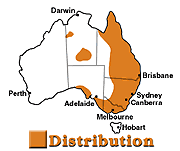In the last few years there’s been a progressive and very alarming rise in the number of deaths from snake bites. Many of those deaths are associated with brown snakes. It’s thought that the reason for the increase is that snakes, and brown snakes in particular, are adapting so well to urban environments.
Snake bite deaths
From available information collected in the 1980s and early 90s, it was reported that there were two to three deaths from snake bite per year in Australia. In the 90s studies suggested that it was three to four. Current data shows that between spring 1997 and autumn 1998 there were at least six deaths. Between spring 1998 and autumn 1999 there have been at least four deaths, maybe more.
Brown snakes
There are several species of brown snake in Australia. Their generic name is Pseudonaja, which means false cobra, and refers to their impressive threat display. The most toxic member of the group, the eastern or common brown snake (Pseudonaja textilis) is found in the eastern half of Australia with a few populations in the Northern Territory. It has the second most potent venom of all land snakes (second only to the inland taipan) and is 12 times more toxic than the Indian cobra (Naja naja). Common Brown Snake (Pseudonaja textilis).
The most widespread species is the western brown or gwardar (P. nuchalis) which occurs everywhere in Australia apart from a strip around the southern and eastern coasts. Brown snakes come in a wide variety of colours and patterns, including brown, orange-red, grey, banded, unbanded and speckled. They have adapted very well to urban and metropolitan areas and can often be found hiding under wood heaps or sheets of corrugated iron. A bite from a brown snake is not usually painful, the fang marks are tiny and sometimes people don’t even realise they’ve been bitten. Even though brown snakes produce relatively small amounts of venom, the venom is very toxic, and following a bite major collapse can occur within half an hour if no first aid has been given. Therefore correct use of first aid is critical.
If you see a snake
leave it alone if it is in the house, close all the doors and confine it to one room if possible telephone one of the wildlife rescue organisations or the National Parks and Wildlife in your state – they can refer you to a snake collector in your area (a fee may apply) do not try to catch it yourself!
First aid for snake bite
Do:
apply a pressure bandage firmly over the bitten area as you would for a sprain – this slows down the passage of the venom through the lymphatic system. Bandage from the bite to the fingers or toes, then back to the groin or armpit. splint the limb avoid moving the patient seek medical attention.
Don’t:
apply a tourniquet or constrictive bandage wash, cut or suck the wound or apply any chemicals to the bite area.
Contact information
For a referral to a local snake collector contact the service listed for your state:
NSW: Wildlife and Information Rescue Service (WIRES), phone: (02) 8977 3333.
VIC: The Wildlife Care Network, phone: 0500 540 000
SA: Fauna Rescue, phone: 08 8289 0896, or Adelaide Snake Catchers, phone: 0413 665 483
QLD: QLD Parks and Wildlife Service, phone: (07) 3202 0220
WA: Conservation and Land Management (CALM), Wildlife Protection, phone: (08) 9334 0292 (BH), (08) 9334 0333 (AH)
NT: Darwin and Darwin Rural Snake Callout, phone: 0407 610 039
TAS: Department of Primary Industry, Water and Environment, Nature Conservation Branch, phone: (03) 6233 6556
ACT: ACT Parks and Conservation – Southside, phone: (02) 6207 2127; Northside, phone: (02) 6207 2113



